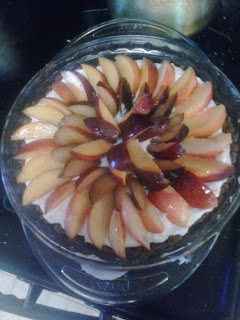Fun fact: Corned beef - as we know it - is hardly eaten in Ireland. It was a product of cultural exchange between the Irish and Jewish populations of New York City, mixing cheap salt beef with pastrami spices. So, really, it's the perfect thing to eat on St. Paddy's as an Irish-American, because it's actually related more to our specific heritage.
* Obligatory judge-y comments about green beer etc*
Anyway. My parents generously filled our freezer with venison from the deer my dad and brother shot last fall. We've been slowly working our way through it since November, and have two small roasts and something labelled "stew" left over, and, while thinking about how delicious corned beef is, I thought...venison is very similar to beef, so why not corn it too?
I googled methods and recipes, and came to two conclusions:
1. This is super easy
2. I need to buy sodium nitrite.
Sodium nitrite is added when curing meat this way to protect against botulism, as well as give it that rosy pink color and distinctive flavor. It's sold mixed with salt and dyed pink, most commonly under the brand name Insta-Cure #1. I wasn't able to track it down at Cub or Wal-Mart, and decided to buy it online instead of driving around to various stores to hunt it down. It's fairly inexpensive, but sold in much larger quantities than needed for this recipe - so if anyone in the area wants to give it a shot, let me know and I'll share! My packet of pink mixed sodiums came in the mail today, so I started out when I got home from work. This is the recipe I used:
Corned Venison
Note: I used only whole spices that I already had on hand. I buy them cheap from a local grocery story's in-house packaged bulk, and keep some around for various uses. Recipes vary, but I kept the most common elements (mustard, coriander, pepper, bay) from several and added extras from a few.
1 1/2 cups salt - kosher or cheap sea salt is best, because it doesn't have that table salt-y flavor that can be off-putting in large amounts
1/2 c sugar
4 level tsp Insta-Cure #1
3 tbsp whole mustard seeds
3 tbsp whole coriander
1 cinnamon stick
5-10 cloves
3 whole bay leaves
2 tbsp whole black pepper
1 cardamom pod
1 star anise - I took this out after about 1 minute because it started to smell like Chinese 5 spice powder and I didn't want that, so proceed as you will. Star anise is supposed to have compounds that bring out the meatiness of meat.
4-6 cloves garlic, chopped roughly - I just cut mine in half
1 gallon water
Venison, beef, any red meat, tougher and fattier cuts preferred, 2-5 lbs
Mix all ingredients except for beef with a few cups of the water in a sauce pan and bring to boil, and stir until the sugar and salt are dissolved. Put the remaining water in whatever container you're brining in - I'm using a big ceramic baking dish - and then add the hot liquid. Let the mixture cool to room temperature, add meat, and cure in the refrigerator for 5-10 days.
When it's ready, rinse it off, and prepare however you like.My favorite way is by boiling and then baking, with a sweet mustard glaze. It's got the falling-apart tenderness of the simmering method, without the boiled taste, and a caramelized, tangy crust.
Oven-Finished Corned Beef With Mustard Brown Sugar Glaze
1 piece of corned red meat
4 tbsp sweet hot mustard
1 tsp mustard seeds, optional
3 tbsp brown sugar
Rinse meat and cover with water in a large pot. Bring to a simmer - not a boil! - and let it cook for about 40 minutes per pound. Drain water and put meat in deep, oven-safe dish, preferably one with a lid, although foil works fine. Slather with mustard, pat sugar on top, and put on lid or foil. Bake at 300 for 90 minutes, or until tender and soft. Take off the lid, and broil for 3-5 minutes to caramelize the sugar. Feast.
Finally: For the potatoes and veggies. I've never liked the common offering of boiled potatoes, carrots, and cabbage - I know it's generally accepted, but I find it bland and insipid. Instead, I like to make colcannon - mashed potatoes mixed with kale or cabbage and green onion. I had cabbage on hand the other day, and rather than just lightly sauteeing it or boiling it with the potatoes, I browned it in butter.I also threw in a handful of frozen spinach for color. The result smelled a little like potstickers and tasted awesome.
Colcannon, not entirely traditional but I'm Irish-American so whatever
5 lbs potatoes, peeled and cut into quarters - I used red potatoes and did not peel them
1 head cabbage
5 stalks green onions, chopped, green and white parts separated
1/2 cup frozen or cooked-down spinach
Butter, a lot
1ish cups milk, warmed
Salt, pepper
Throw potatoes in a pot of cold, salted water and boil until tender, 10-20 minutes depending on the size and type. Meanwhile, slice cabbage into 1/4in slices and then again into smaller segments. Fry with white parts of the green onions in butter - I think, all told, it was about 6 tbsp, since I worked in batches and wasn't going to add extra butter to the potatoes - until brown and toasty and it smells like gyoza heaven. Drain potatoes, and put back into the boiling pot. Mash to whatever level of smoothness you prefer. Add warm milk in small amounts until it's as thin or thick as you like your mashed potatoes. Stir in green onions and cabbage and and salt and pepper (and, okay, extra butter) to taste.
Links:



